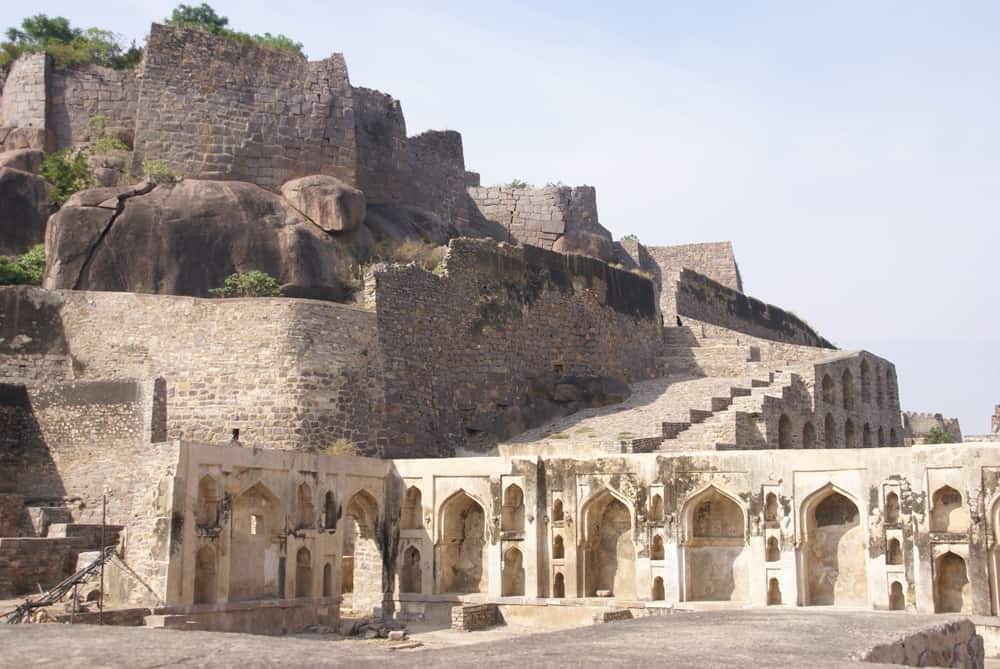 ShutterstockSitting on the Bay of Bengal in southern India, Andhra Pradesh on the Deccan Plateau is a land of grand temples rising from hillocks, spectacular Buddhist Stupas and the excavated splendour of an ancient university. Visitors hear tales of power and patronage from a glorious past, learn about the amalgamation of Hindu and Muslim influences and wander along 1,000 kilometres of coastline.
ShutterstockSitting on the Bay of Bengal in southern India, Andhra Pradesh on the Deccan Plateau is a land of grand temples rising from hillocks, spectacular Buddhist Stupas and the excavated splendour of an ancient university. Visitors hear tales of power and patronage from a glorious past, learn about the amalgamation of Hindu and Muslim influences and wander along 1,000 kilometres of coastline. The Buddhist religion spread to Sri Lanka and Myanmar from the bustling ports of Andhra Pradesh, and one of India’s richest Buddhist sites, Nagarjunakonda (known as Sri Parvata in ancient times) now lies almost entirely under the waters behind the Nagarjunasagar dam. However, the monasteries and chaityas were taken brick by brick and reconstructed on top of a hill called Nagarjunakonda that rises from the middle of the dammed lake. The island takes its name from the Buddhist monk, Nagarjuna, who lived around the turn of the 2nd century and was the exponent of the philosophy of ‘sunyata’ (Void). And Konda in the Telugu language means hill. Nagarjunakonda is about 150 kilometres southeast of Hyderabad, and is reached by a regular ferry service. Remains of a Buddhist University have been relocated to Anupu, four kilometres from here and the Ethipothala waterfalls are nearby.
 ShutterstockAmaravati (ancient Dhanyakataka) is about 38 kilometres from Vijayawada and can also be reached at Guntur 35 kilometres away. An emissary of the Emperor Ashoka who went to propagate Buddhism in the region in the 2nd Century B.C. laid the foundation of the Great Stupa at Amaravati. There is an Archeological Museum here.
ShutterstockAmaravati (ancient Dhanyakataka) is about 38 kilometres from Vijayawada and can also be reached at Guntur 35 kilometres away. An emissary of the Emperor Ashoka who went to propagate Buddhism in the region in the 2nd Century B.C. laid the foundation of the Great Stupa at Amaravati. There is an Archeological Museum here.Hyderabad, the capital city of Andhra Pradesh lies on the banks of the Musi River across from its twin city Secunderabad. The city was founded in 1599, after a water shortage in Golconda. Hyderabad is also known as the “City of Pearls” for its flourishing pearl trade. These days it is a major hub of India’s software industry.
Hyderabad’s most enduring emblem is the Charminar, meaning literally four minarets. You can enjoy breathtaking views from the top of the minarets without climbing up via tele-robotic cameras controlled by touch screens in kiosks on the ground. The Old City around Charminar is worth exploring. Don’t missed Laad Bazaar, the famed bridal-ware market and do not leave Hyderabad without sampling its signature biryani.
 ShutterstockSavour the untold wealth of the Hyderabad’s Nizams at the Nizam’s Museum, and the wonders of arguably the largest one-man collection of artifacts and antiques from around the world at the Salara Jung Museum.
ShutterstockSavour the untold wealth of the Hyderabad’s Nizams at the Nizam’s Museum, and the wonders of arguably the largest one-man collection of artifacts and antiques from around the world at the Salara Jung Museum. Mecca Masjid is one of the largest mosques in India, so called because the bricks used to make the central arch came from Mecca. Visits to Qutb Shahi Tombs, Hussain Sagar and Osman Sagar lakes, and, Ramoji Film City are must-dos.
Golconda Fort is one of India’s most famous forts. Originally built of mud in the 12th century, it was later the capital of Qutb Shahi’s Dynasty from 1518 to 1687. The diamond vault here once held the Koh-i-noor and Hope diamonds. The fortress is famous for its acoustics, palaces, ingenious water supply system and Fateh Rahben gun. A son-et-lumiere show is held daily.
 Shutterstock
ShutterstockPrasantinilayam, the abode of peace and home of Satya Sai Baba in Puttaparti is world renowned. Places of historical interest like Penukonda and Rayadurgam forts and religious places like Lepakshi (famous for the Veerbhadra Temple) and Dharmavaram are all in the district of Anantapur. Another reason to visit is Thimmammma Marrimanu, an amazing 550-year-old banyan tree that has even made it to the Guinness Book of World Records.
Andhra Pradesh also offers a wealth of rejuvenation experiences through health tourism. Hyderabad is famous for its fish medicine – a miracle cure for asthmatics disbursed free of cost, where a secret medicine is stuffed into a live fish, which the patient has to swallow whole.
One of India’s most prosperous and vibrant temples, attracting millions of visitors from around the globe, is the Tirupati Lord Venkateswara Temple popularly known as Tirupati, the name of the town.
The Nagarjunasagar Srisailam Sanctuary, 130 kilometres from Hyderabad, is one of the biggest successes of Project Tiger. Birdwatchers can head to Manjira Sanctuary just 50 kilometres from Hyderabad.
The beaches of Andhra Pradesh are in Visakhapatnam, the second largest city. The beach at Rishikonda is ideal for wind and water surfing. Bheemunipatnam, or Bhimli, was once a Dutch settlement and the Dutch Cemetery is worth a visit. Machilipatnam, known for its Kalamkari art (art of printing on fabric with vegetable dyes), also has a beach.
There are Hill Stations like Horsely Hills at an elevation of 1,265 metres, and Araku, a valley at 975 metres. The rail journey to Araku passes several waterfalls and numerous tunnels. Borra Caves boasts stalactites and stalagmites millions of years old that are well illuminated.
For shopping, Hyderabad is famed for pearls, excellent Bidriware and lacquer bangles embellished with semi-precious stones; Pembarti for sheet metal art; Cheriyal Village for scroll painting, batik wall hangings, Nirmal paintings and Kondapali toys.
For more information on the amazing culture of Andhra Pradesh, contact Indiatourism, Toronto at info@indiatrouismcanada.ca or visit www.incredibleindia.org.


